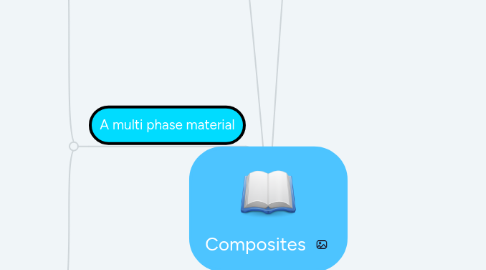
1. A multi phase material
1.1. Matrix phase
1.1.1. Can be
1.1.1.1. Metal
1.1.1.2. Ceramic
1.1.1.3. Polymer
1.1.2. Function
1.1.2.1. Binds fibers together
1.1.2.2. Medium in which externally applied stress is transmitted
1.1.2.3. Protect individual fibers from surface damage
1.1.2.4. Separates the fibers
1.1.2.5. Barrier to crack propagation
1.1.3. Properties
1.1.3.1. Ductile
1.1.3.2. Elastic modules is much lower than that of a fiber
1.2. Fiber phase
1.2.1. High tensile strength
1.2.2. Types
1.2.2.1. Whiskers
1.2.2.1.1. Very thin crystal with extreme length-to-diameter ratio
1.2.2.1.2. Among of the strongest known materials
1.2.2.1.3. Extremely expensive
1.2.2.1.4. Material
1.2.2.2. Fibers
1.2.2.2.1. Small diameters
1.2.2.2.2. Either
1.2.2.3. WIres
1.2.2.3.1. Large diameters
1.2.2.3.2. Material
2. Particle-reinforced
2.1. Large-Particle
2.1.1. Types
2.1.1.1. Cermets
2.1.1.1.1. Ceramic-metal composites
2.1.1.1.2. Cemented carbide
2.1.1.2. Concrete
2.1.1.2.1. Too little water leads to incomplete bonding & to much results in excessive porosity
2.1.1.2.2. Portlans Cement Concrete
2.2. Dispersion strengthened
2.2.1. Atomic/molecular interactions
3. Structural
3.1. Laminates
3.1.1. Composed of 2 dimensional sheets or panels
3.1.2. Each sheet has a preferred high-strength direction
3.1.3. Multi-layered structure
3.1.4. Common ingredients
3.1.4.1. Carbon
3.1.4.2. Glass
3.1.4.3. Aramid
3.1.5. Common Techniques for post-lay-up
3.1.5.1. Autoclave molding
3.1.5.2. Pressure-bag molding
3.1.5.3. Vacuum-bag molding
3.1.6. Common uses
3.1.6.1. Aircraft
3.1.6.2. Automotive
3.1.6.3. Marine
3.1.6.4. Building/civil-infrastructures
3.2. Sandwich panels
3.2.1. Combination of 2 outer sheets with a bonded inner core
3.2.2. Outer sheets are usually stiffer than inner
3.2.2.1. Aluminum alloys
3.2.2.2. Steel
3.2.2.3. Stainless steel
3.2.2.4. Fiber-reinforced plastics
3.2.2.5. Plywood
3.2.3. Core material is usually lightweight and has a low modulus of elasticity
3.2.3.1. Functions
3.2.3.1.1. Provides continuous support
3.2.3.1.2. Hold faces together
3.2.3.1.3. Withstands transverse shear stresses
3.2.3.1.4. Provides high shear stiffness
3.2.3.2. Core materials
3.2.3.2.1. Rigid polymeric foams
3.2.3.2.2. Wood
3.2.3.2.3. Honeycomb
4. Fiber-reinforced
4.1. Influence
4.1.1. Fiber length
4.1.1.1. Critical fiber length
4.1.1.1.1. lc = (σ*fd)/2tc
4.1.1.2. length increases, fiber reinforcement becomes more effective
4.1.1.3. If fiber length is > critical length
4.1.1.3.1. Continuous, Discontinuous or Short fibers
4.1.2. Orientation & Concentration
4.1.2.1. Discontinuous(short)
4.1.2.1.1. Aligned
4.1.2.1.2. Randomly oriented
4.1.2.2. Continuos(aligned)
4.1.2.2.1. Strength dependent on direction
4.1.2.2.2. Mechanical responses depend on
4.1.2.2.3. Longitudinal
4.1.2.2.4. Transverse
4.2. Types
4.2.1. Metal matrix composites
4.2.1.1. Ductile
4.2.1.2. Advantages
4.2.1.2.1. Higher operating tempratures
4.2.1.2.2. Non flammabil
4.2.1.2.3. Greater resistance to degradation
4.2.1.3. Reinforcements
4.2.1.3.1. Specific stiffness
4.2.1.3.2. Specific strength
4.2.1.3.3. Abrasion resistance
4.2.1.3.4. Creep resistance
4.2.1.3.5. Thermal conductivity
4.2.1.3.6. Dimensional stability
4.2.1.4. Materials
4.2.1.4.1. Matrix
4.2.1.4.2. Fibers
4.2.2. Polymer matrix composites
4.2.2.1. Polymer resin as matrix and fibers as reinforce material
4.2.2.2. Types
4.2.2.2.1. Glass fiber-reinforced polymer
4.2.2.2.2. Carbon fiber-reinforced polymer
4.2.2.2.3. Aramid fiber-reinforced polymer
4.2.2.2.4. Other fiber-reinforced material
4.2.2.2.5. Polymer-matrix material
4.2.3. Hybrid composites
4.2.3.1. When using 2 or more types of fibers in a single matrix
4.2.3.2. Most common
4.2.3.2.1. Carbon and glass fibers in polymetric resin
4.2.4. Carbon-Carbon composites
4.2.4.1. Expensive
4.2.4.1.1. Complex processing techniques
4.2.4.2. High tensile moduli
4.2.4.3. High tensile strength
4.2.4.3.1. @2000°C
4.2.4.4. Resistance to creep
4.2.4.5. Relatively large fracture toughness
4.2.4.6. High thermal conductivity
4.2.4.7. Low thermal expansion
4.2.5. Ceramic matrix composites
4.2.5.1. Brittle
4.2.5.2. Several techniques are uses to retard crack propagation
4.2.5.2.1. Phase transformation
4.2.5.2.2. Ceramic wiskers
4.2.5.3. Fabrication
4.2.5.3.1. Hot pressing
4.2.5.3.2. Hot isostatic pressing
4.2.5.3.3. Liquid-phase sintering
4.3. Processing
4.3.1. Pultrusion
4.3.1.1. Continuous length
4.3.1.2. Constant cross-sectional shape
4.3.1.3. Method
4.3.1.3.1. Fibers are impregnated with thermosetting resin
4.3.1.3.2. Rolled through a die to the acquire shape and resin/fiber ratio
4.3.1.3.3. Passes through a curing die for final shape and cures resin matrix
4.3.2. Prepreg
4.3.2.1. Preimpregnated fibers with polyester resin
4.3.2.2. Directly molds and fully cures without adding resin
4.3.2.3. Method
4.3.2.3.1. Prepreg fibers start on rolls
4.3.2.3.2. They get sandwiched and pressed between sheets of release and carrier paper by heated rollers
4.3.2.3.3. A doctor blade spreads the resin
4.3.2.3.4. The release and carrier paper are removed and the final prepreg is prepared for packaging
4.3.3. Filament winding
4.3.3.1. Continuous reinforced fibers are accurately positioned in a predetermined pattern to form a hollow shape
4.3.3.2. Method
4.3.3.2.1. The fibers are fed through a resin bath
4.3.3.2.2. Then wound onto a mandrel
4.3.3.2.3. After appropriate number of layers is applied, curing is carried out
4.3.3.2.4. Thereafter the mandrel is removed
5. Nano
5.1. Nano sized particles embedded in matrix material
5.2. Can be designed to have specific properties
5.2.1. Magnetic
5.2.2. Mechanical
5.2.3. Electrical
5.2.4. Optical
5.2.5. Thermal
5.2.6. Biological
5.2.7. Transport
5.3. Degree of change depend
5.3.1. Particle size
5.3.2. The increase in ratio of particle surface area to volume
5.4. Composition
5.4.1. Matrix
5.4.1.1. Materials
5.4.1.1.1. Metals
5.4.1.1.2. Ceramics
5.4.1.1.3. Epoxy resin
5.4.1.1.4. Polyurethanes
5.4.1.1.5. Polypropylene
5.4.1.1.6. Polycarbonate
5.4.1.1.7. Poly
5.4.1.1.8. Silicone resin
5.4.1.1.9. Polyamides
5.4.1.1.10. Ethylene vinyl alcohol
5.4.1.1.11. Butyl rubber
5.4.1.1.12. Natural rubber
5.4.2. Nanoparticle
5.4.2.1. Nanocarbons
5.4.2.1.1. Single- & multi wall carbon nanotunes
5.4.2.1.2. Graphene sheets
5.4.2.1.3. Carbon nanofibers
5.4.2.2. Nanoclays
5.4.2.2.1. Layered silicated(most common montmorillonite)
5.4.2.3. Particulate nanocrystals
5.4.2.3.1. Inorganic oxides
5.5. Most popular
5.5.1. Gas-barrier coating
5.5.1.1. Montmorillonite nanoclay particles
5.5.1.1.1. Used to keep air and water in or out
5.5.1.1.2. Food packaging
5.5.1.1.3. Tires,balls ect
5.5.2. Energy storage
5.5.2.1. Graphene nanocomposites are used in batteries
5.5.2.1.1. Capacity is higher
5.5.2.1.2. Life cycles are longer
5.5.2.1.3. Double the power is available
5.5.3. Flame-barrier coatings
5.5.3.1. Multi-walled carbon nanotubes dispersed in silicone matrices
5.5.3.1.1. Flame barrier
5.5.3.1.2. Abrasion & scratch resistant
5.5.4. Dental restorations
5.5.4.1. Nano clusters composed of silica and zirconia
5.5.4.1.1. High fracture toughness
5.5.4.1.2. Wear resistant
5.5.4.1.3. Short curing times
5.5.4.1.4. Curing shrinkages
5.5.5. Mechanical strength enhancements
5.5.5.1. Adding multi-walled carbon nanotubes into epoxy resin
5.5.5.1.1. High strength and lightweight polymer
5.5.5.1.2. Used in wind turbine blades
5.5.6. Electrostatic dissipation
5.5.6.1. Multi-walled carbon nanotubes in polymers
5.5.6.1.1. Used in transport in highly flammable fuels ect.
5.5.6.1.2. To prevent static charges
